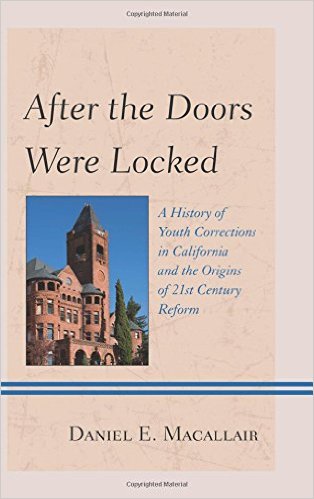 After the Doors Were Locked: A History of Youth Corrections in California and the Origins of Twenty-First Century Reform
After the Doors Were Locked: A History of Youth Corrections in California and the Origins of Twenty-First Century Reform
By Daniel E. Macallair
Rowman & Littlefield Publishers, 2015
350 pages
In California and across the United States, youth corrections systems have often demonstrated an inability to shape their practices to meet children’s actual needs. While other countries have dramatically lower numbers of incarcerated youth or no incarcerated youth at all, the United States continues to imprison tens of thousands of children, often in large, secure institutions that employ practices such as solitary confinement, cell block living and inflexible discipline policies originally conceptualized in adult settings.
In his new book, “After the Doors Were Locked: A History of Youth Corrections in California and the Origins of Twenty-First Century Reform,” Daniel Macallair calls on his readers to heed the lessons of history and positively transform existing remnants of California’s largely misguided youth corrections system. Ultimately, his book provides food for thought not only for California practitioners, but also for professionals across the country.
By illuminating the interwoven threads of California case law, legislation and public opinion, Macallair provides an informative look at how and why the California youth corrections system has changed over the past 150 years — and how it may be moving toward correcting its mistakes. While readers may be familiar with the origins of the American juvenile court system and the current structure of California youth corrections, Macallair presents a rich account of lesser-known historical events that occurred before and between those two milestones.
A sizable portion of the book traces the links between California’s first “industrial school” and the reform schools that followed it, all before the state’s juvenile court system was established by statute. In discussing the impact of these facilities on youth, Macallair explores low points in the state’s history, including the eugenics movement in the early 20th century.
During this period, reform school administration conducted intelligence testing, and youth adjudged as “feebleminded” were transferred to state mental hospitals — where they were sterilized. Macallair also examines the disparities between treatment of male and female youth at the reform schools, including the low prioritization of education and rehabilitative activities for girls.
Moving into the more modern era, Macallair tracks the fast rise and eventual fall of the state’s youth corrections agency, the California Youth Authority (CYA). The CYA was created in the mid-20th century with good intentions to consolidate and better control the vast network of state correction facilities. However, as Macallair takes care to describe, poor leadership, the changing corrections philosophy from rehabilitative to punitive practice, and the establishment of strict sentencing all had roles to play in the agency’s tumble from grace.
While Macallair admirably combines nearly two centuries of history into a highly readable narrative, the historical treatment of youth of color could be highlighted more thoroughly. The topic is given some attention throughout the book, but one relevant point is missing: Youth of color in the United States were often excluded from the formal juvenile corrections process and instead subjected to adult corrections or vigilante violence (e.g. lynching) because of deep-rooted racism.
This treatment of youth of color may not have been the norm in California. However, Macallair could include a discussion of this practice and its impact on youth of color in the segment of the book surveying national practices that ultimately impacted California youth corrections.
Macallair ends his book with a firm recommendation for California’s youth corrections system: He advocates that the state close its remaining state institutions and advance more quickly toward county-based youth corrections. A county-based system, he argues, has the ability to be more innovative and responsive to modern research on youth corrections. Additionally, a county-based system would be more accountable than the state system.
Macallair’s recommendation is sound. However, it remains to be seen whether county-based corrections systems can attain the balance between public safety and youth rehabilitation that state youth corrections have neglected to achieve over the past 150 years. Hopefully, California will ultimately accept that institutional confinement is no place for youth and move toward family- and community-based juvenile justice interventions.
Regardless of your viewpoint on the conditions of confinement and closure of state institutions, “After the Doors Were Locked” underscores a valuable point. In dreaming up new solutions for youth rehabilitation and treatment, we have a responsibility to understand the mistakes our state and citizenry have made in reaching this point in youth corrections reform, so that we do not repeat those mistakes to the detriment of future generations of young people.
Atasi Uppal is a staff attorney for the National Center for Youth Law (NCYL). Part of NCYL's Juvenile Justice and FosterEd teams, she leads program development and policy reform aimed at closing the achievement gap for young people in the juvenile justice system..
According to Avvo.com: “A conflict attorney is a private attorney who works with, but not for, the public defender’s office. A lawyer can only represent one defendant per case as multiple defendants have conflicting interests. When a PD declares a conflict a private attorney is appointed to represent the 2nd defendant.”
What is a conflict attorney?